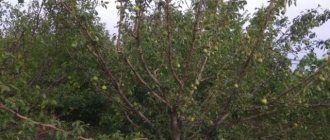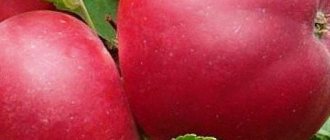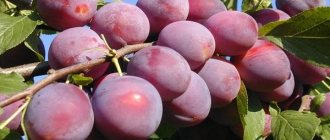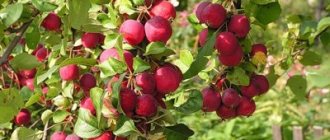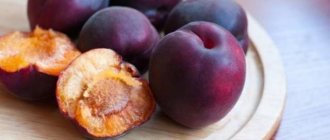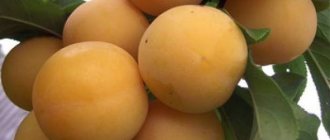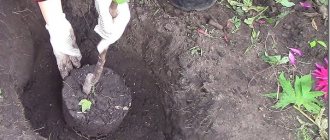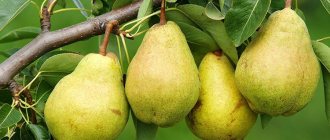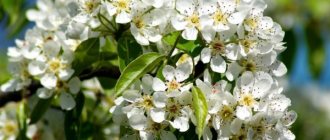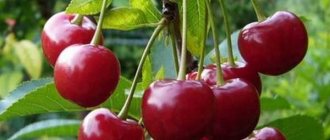Features of caring for apricot varieties Kichiginsky
After the apricot has been planted in a permanent place, it is necessary to provide the tree with proper and timely care, which includes watering, fertilizing, and crown formation
It is equally important to take preventive measures against the emergence of diseases and pests in a timely manner.
Feeding and watering
It is necessary to water the Kichiginsky apricot 2 times per season: during the period of shoot growth and fruit ripening. One tree consumes 30 liters of water, and it must be warm and settled. The liquid should be applied directly under the tree trunk.
As for fertilizer, this process is carried out 2 years after planting. Fertilize the plant in the spring, before buds begin to bloom, with ammonium nitrate or urea. For 1 m² of crown projection, 8 g of the substance is needed. At the beginning of summer, you need to feed the trees with a solution of mullein in a ratio of 1:20 to water or replace this mixture with a solution of chicken manure in a ratio of 1:10 to water.
Trimming methods
Pruning of trees of this variety is carried out in order to give the crown a certain shape (such pruning is called formative pruning), as well as to free the tree from damaged branches. To improve the health of the tree, it is necessary to prune defective and frostbitten branches in early spring. Since apricot is a crop that needs sufficient light, it is necessary to thin out the tree crown by cutting off thickening branches. To do this, use garden shears or a sharp knife.
To ensure easy harvesting, the crown can be shaped like a bush. Another option is a cup-shaped crown. To do this, it is necessary to leave 5–6 shoots, the length of which should be 40–50 cm, and branches up to 30 cm long should be pinched for further branching. In this case, the central conductor is removed.
Diseases and pests
Despite the high immunity of the declared apricot variety, it is still susceptible to some diseases, and with improper care, the plant can become infected with parasites.
Apricot Kichiginsky can be affected by the following diseases:
- Fruit rot. The main symptom of this disease is the appearance of brown spots on the fruit, as a result of which the process of rotting occurs and the fruit becomes unfit for consumption. To get rid of fruit rot, you need to treat the apricot with a solution of Horus or Nitrafen. As a preventative measure, it is necessary to remove fallen leaves from under the tree and burn them outside the site.
- Scab. The presence of the disease can be determined by the appearance of green or brown spots on the leaves, which gradually move to the fruits. To get rid of this disease, you need to treat the plant with products that contain copper. To protect the Kichiginsky apricot from scab, you need to promptly remove fallen leaves and also adhere to the rules for caring for this crop.
In addition, the Kichiginsky variety is subject to invasion by the following pests:
- Leaf roller. The main sign of its appearance is the foliage rolled into a tube, as well as the appearance of cracks in the bark. To get rid of the pest, you need to treat the plant with Chlorophos. For preventive purposes, the plant should be sprayed with insecticides in early spring and late autumn.
- Weevil. It affects leaves and inflorescences; in severe forms of the disease, the leaves fall off. The preparations “Decis” and “Kinmiks” are used to treat the tree. For prevention purposes, they dig up the soil around the tree trunk, and in early spring and late autumn they treat the plant with insecticides.
Diseases and pests, methods of control and prevention
| Type of disease | Symptoms | Control measures | Prevention |
| Fruit rot | Brown spots on fruit that grow and cause fruit to rot. | Treatment with solutions of Horus or Nitrafen. |
|
| Scab | Green and brown spots on the leaves, the damage gradually spreads to the shoots and fruits. | Treating trees with preparations containing copper. |
| Pest | Signs of defeat | Control measures | Prevention |
| leaf roller | Leaves curled into a tube, cracks appearing on the bark. | Treatment of trees with Chlorophos. |
|
| Weevil | Affected leaves, buds and flowers. When severely damaged, the tree sheds its leaves. | Spraying with Decis or Kinmiks. |
The formation of brown spots on the fruit indicates damage to fruit rot. Trees are treated with Horus or Nitrafen.
Green marks on the leaves, as well as with a brown tint, gradually affecting the shoots and fruits, are caused by scab. In such situations, treatment is carried out with products that contain copper.
If the leaves curl into a tube and cracks appear on the bark, this means that there is a leaf roller on the tree. Chlorophos can save you from it.
A sign of a weevil invasion is damage to leaves, buds, and flowers. Serious lesions lead to loss of leaves. Spraying with Decis or Kinmiks will help get rid of the pest.
Prevention against parasites is as follows: dig up the soil around the tree trunk and treat the Kichiginsky apricot with insecticides in early spring and late autumn.
Apricot "Kichiginsky": planting technology and care recommendations
Apricot “Kichiginsky” was obtained by experienced domestic breeders of the South Ural Research Institute of Horticulture and Potato Growing K.K. Mulloyanov and A.E.
Pankratova as a result of sowing seed material from Manchurian apricot through free pollination.
It is included in the State Register for the Ural region and belongs to the well-known varieties of medium ripening.
The description of the variety characterizes it as high-yielding, with high winter hardiness. "Kichiginsky" apricot is a good pollinator for many other varieties of apricot. The harvested crop can be used universally.
Description and characteristics of the variety
Apricot variety "Kichiginsky" forms medium-sized trees with a flat and very attractive crown with average density. Plants enter the fruiting stage in the fifth year. The shoots are characterized by average thickness, upright growth, and dark red color. The leaves are medium sized, round in shape, dark green in color.
Round and attractive yellow apricots. The average weight of the marketable fruit is 13.5-14.5 g. The pulp is yellow, very juicy, and has a sweet and sour taste. According to the tasting results, the ripe fruits received a score of 4.5 points.
To successfully grow apricots, you must follow the planting technology and provide the plant with proper care at all stages of the growing season.
Technology and planting scheme
Proper planting of the Kichiginsky apricot requires adherence to time-tested technology and the experience of gardeners:
- for planting, it is necessary to select a well-lit, flat or slightly sloping area;
- You should not choose areas with high groundwater levels for growing apricot plantations;
- it is advisable to allocate areas for planting that are protected from gusty and cold winds by buildings;
- the soil must not only be fertile, but also have good air permeability;
- planting holes must be prepared in advance: for spring planting - in the fall, and for autumn planting - approximately two to three weeks before planting fruit seedlings.
It is mandatory to backfill high-quality drainage to the bottom of the planting hole. A layer of broken bricks or large crushed stone will help protect the root system of fruit seedlings from rotting due to the increased amount of moisture.
How to plant an apricot (video)
Sandy loam and sandy soils should be improved with peat and organic matter with mineral fertilizers.
In the presence of sod-podzolic soils, deep digging is carried out with liming and the application of organic and mineral fertilizers.
Clay soil should be cultivated with river sand and sawdust with the addition of manure, humus or compost with mineral fertilizers.
High-quality filling of the planting hole with fertile nutrient soil with the addition of basic fertilizers allows you to provide plants with optimal conditions for growth and development during the first couple of years. Proper care after planting is the key to obtaining high-quality and abundant annual fruiting of apricots.
Rules of care
When growing Kichiginsky apricot, it is recommended to carry out the following measures to care for fruit plants:
- In early spring, apricot trees are fertilized annually with high-quality organic fertilizers;
- apricots remove significantly more potassium from the soil than nitrogen, which requires the mandatory use of nitrogen-containing fertilizers;
- Proper feeding of mature apricot trees is of particular importance: in early spring it is recommended to carry out liquid fertilizing from bird droppings with the addition of compost or peat at the rate of 0.3-0.5 kg per square meter of crown projection;
- fertilizing should be combined with watering, which should be done in special furrows.
It is also necessary to carry out preventive spraying and high-quality preparation of fruit plants for the winter period.
Reviews from gardeners in the Urals and other regions are mostly positive. The variety has excellent winter hardiness, and if agricultural practices are followed, the yield can reach 14-15 kg. The harvested crop is transportable.
The disadvantages include significant growth strength and the presence of an elongated oval crown, which somewhat complicates the care of fruit plants and harvesting.
History of selection
Work on cold-resistant hybrids began in the 30s of the 20th century. Employees of the South Ural Research Institute of Horticulture and Potato Growing used natural plant forms for selection.
The seeds of Manchurian apricot growing in natural conditions were brought from the Far East. This species is not picky about soil, tolerates winter frosts and drought well, and produces small, juicy fruits.
During the entire period of work at the institute, 5 new varieties were bred, including Kichiginsky. The variety was obtained in 1978 by open pollination of Manchurian apricot. It received its name in honor of the village. Kichigino, Chelyabinsk region. Breeders A.E. worked on the hybrid. Pankratov and K.K. Mulloyanov.
In 1993, the institute submitted an application to include the Kichiginsky hybrid in the State Register. In 1999, after testing, information about the variety was entered into the State Register for the Ural region.
Apricot Kichiginsky is used in breeding to obtain elite varieties. The most famous of them are Honey, Elite 6-31-8, Golden Nectar. From Kichiginsky they took high yield, winter hardiness and good external qualities of the fruit.
Description and characteristics of the Akademik apricot variety, planting, cultivation and care
Common apricot is a perennial deciduous tree of the Plum genus of the Rosaceae family. This is a fruit that is most often grown in gardens in regions with warm, mild climates, but there are varieties suitable for harsh climates. I.V. Michurin began work on developing winter-hardy apricot varieties. Gradually, new apricot varieties began to appear, such as Academician.
History and description of the variety
The variety was developed more than 20 years ago and was included in the State Register in 1996. At the experimental station of the Far Eastern Research Institute of Agriculture in the Khabarovsk Territory, the institute’s specialists G. T. Kazmin and V. A. Marusich crossed two winter-hardy varieties Khabarovsky and Sputnik, the result was subsequently recommended for cultivation in the Far Eastern region. Since 1972 it has been included in the register of promising varieties, and since 1975 in elite varieties.
Description of apricot variety Akademik
The tree is tall, up to 5 m, the trunk is rough, lumpy, dark gray, young branches are green-gray. Buds are formed on one-year and two-year branches, 3 pieces each. together, large, light brown, cone-shaped.
The flowers are large white with pink splashes on short petioles. After flowering, they form green fruits, which, when ripe, become orange with a pink blush on the sides. The shape of the fruit is round, elongated, with a small protrusion-beak. The skin is thin, tasty, tender, the flesh is juicy, sweet and sour, yellow in color. Inside the fruit there is a round-flattened stone with a rib, the kernel is sweet.
Characteristic
Apricot Academician is partially self-fertile; for greater productivity, pollinators are needed Amur, Khabarovsk:
- Frost resistance of the root system from -38 to -40 °C.
- Early ripening period, blooms in the 1st-2nd decade of May, from the 10th to the 25th, the fruits ripen at the end of July - 1st decade of August.
- Not subject to weathering.
- Akademika seeds are used as a parent variety for breeding new hybrids.
- Drought-resistant apricot, resistant to waterlogging in the upper layer of the ridge, burn-resistant.
- High-yielding apricot up to 124 c/ha.
- The fruits have a long shelf life, up to 7 days in room conditions.
- Do not crack.
- They tolerate transportation well, do not wrinkle, and have a marketable appearance.
- Resistance to diseases and pests is average.
- It has a long fruiting period of up to 40 years.
The fruits contain sugar more than 11%, acid about 3%, dry matter no more than 17%.
Advantages and disadvantages
The disadvantage of the apricot variety Akademik is freezing when planted in coastal areas, lowlands of rivers, and in wet soils and gets monilial burn. Academician has many advantages: winter hardiness, abundant harvest, sweet large fruits, transportability, good presentation, used for cooking, dried, made into juice, consumed fresh.
Features of cultivation
In the Far Eastern region, the Academician apricot should be planted in well-drained soil on hillocks; it is better to avoid places where groundwater is closer than 2 m. It requires fertile soil with a neutral acidity level, so before planting you need to check the pH, if it is high, add lime . Seedlings are planted in spring or autumn in most regions, but for Siberia and the Urals it is better to plant in spring.
The planting site should be sunny, without drafts; the pollinator should be planted on the site at a distance of no more than 40 m.
Diseases and pests
Academician is resistant to diseases, but can be affected by gray or fruit rot, clasterosporia, to avoid these diseases, it is necessary to follow agricultural cultivation techniques, carry out preventive spraying and sanitary pruning. If the apricot is sick, then it is worth spraying with Bordeaux mixture, Skor, Horus or another fungicide.
Pests of the Academician apricot are aphids, codling moths, and leaf rollers; to get rid of them, it is enough to spray them with insecticides in spring and autumn, as well as dig up the trunk circles and clear them of leaves.
Harvesting and storage
The harvest is harvested as it ripens in July-August. Harvesting begins when the fruits reach the declared size, color and taste, but remain firm, i.e., they have reached consumer maturity. Overripe fruits fall off, so you must not miss the optimal harvest time. For transportation, it is better to pick apricots 2-3 days before consumer ripeness, which improves the quality of transportation, and the fruits can ripen over time.
Did you know? Apricot has several names - “Armenian plum”, “fruit of health”. In India, it is considered a symbol of longevity, because the apricot tree lives for more than 100 years.
For personal consumption, ripe and soft fruits are suitable, which by this time gain more sweetness. The best time to collect is in the morning after the dew has dried and in the evening after 5 p.m. Fruits picked in the dew and midday heat have a worse shelf life. The shelf life of ripe fruits is 2–4 days at room temperature or 5–7 days in the refrigerator.
For long-term storage (up to 3 weeks), apricots should be wrapped in parchment paper, placed loosely in wooden boxes and stored in a room with a temperature of +10...+15°C and a humidity of 50–60%. The fruits should be picked almost ripe. By planting the Gold Rich apricot variety on your plot and providing the tree with proper care, you will receive a harvest of wonderful sunny fruits, and the taste will delight you and your loved ones.
Features of growing apricot Kichiginsky
Caring for the Kichiginsky apricot is generally simple, but there are some features associated with the region where the crop is grown. They are caused by the climatic conditions of the Urals and Siberia, which are characterized by low temperatures in winter and spring frosts and thaws. In southern latitudes, Kichiginsky is not widespread due to the presence of a large assortment of this crop for warm climates.
Landing
Plant apricots in an open sunny place where there is no wind. To reduce the risk of the root collar becoming warm when planting Kichiginsky, it is also necessary to ensure that a lot of snow does not accumulate at the planting site in winter. You can plant an apricot on a mound, but in very snowy winters this technique does not always save.
To prevent the root collar from becoming warm, the apricot is planted on a mound.
If it is difficult to find a good place to plant an apricot, then you will have to take preventive measures to prevent overheating.
As soon as the first snow falls, you need to immediately free the trunk from it so that the soil under the root collar freezes as deep as possible. At the end of winter (before the start of thawing), in the tree trunk circle at a distance of up to one and a half meters from the trunk, you need to thoroughly clear the ground of snow. It is also necessary to dig grooves to drain melt water.
The recommended planting pattern for Kichiginsky is 3x5 m. On heavy soils, drainage is placed at the bottom of the planting hole to regulate the humidity level. Otherwise, when planting Kichiginsky, standard requirements are observed, as for other representatives of this culture.
Video: how to properly plant apricots in the Urals
Apricot care Kichiginsky
Given the complexity of climatic conditions, the seedling should be protected from possible freezing for the first 3–4 years after planting. You can make a frame and cover it with film or spunbond. A simpler option would be to wrap it, for example, in burlap or any other materials through which the plant receives oxygen.
One of the options for covering a young apricot for the winter using a frame
Apricot Kichiginsky can grow quite tall, so it is better to use a sparsely tiered crown formation. Since the tree is not prone to thickening, it will be possible to do without regulatory pruning. But it is not recommended to neglect sanitary pruning; it must be carried out at the end of autumn.
Apricot is considered to be drought-resistant. Yes, if there is a lack of moisture, the tree will not die, but it will affect the harvest. Therefore, apricots need to be watered 3-4 times per season; they especially need moisture immediately after flowering and during intensive fruit growth.
If the holes were filled with organic fertilizers during planting, then they begin to be applied after 3–4 years. Feed with complex mineral fertilizers annually.
Nitrogen fertilizers for feeding can be used only until mid-summer, and it is also better to combine them with potassium and phosphorus.
Video: practicing gardeners about fertilizing apricots
Apricot is quite resistant to disease and rarely gets sick when the weather is favorable for it. In years when the summer is cold and rainy, fungal diseases may appear.
Table: possible apricot diseases and their signs
| Disease | Signs |
| Moniliosis (monilial burn) | Shoots and leaves turn black and dry out, and the fruits rot. |
| Clusterosporiasis (hole spotting) | Leaves and fruits are affected. Pinpoint fungal infections appear on the leaves, in place of which holes form. Dots also appear on the fruits, which grow until the berries are completely covered with scabs. |
| Cytosporosis | Most often it affects skeletal wood. Necrosis and gum formation appear, the bark begins to crack and peel. Skeletal branches or the entire tree may dry out. |
Photo gallery: common fungal diseases of apricot
Apricot fruits affected by moniliosis When apricot clusterosporosis causes holes to form on the leaves and growing spots on the berries. When apricot cytosporosis causes the entire tree to die.
To prevent fungal diseases, trees are sprayed with a 3% solution of Bordeaux mixture or other fungicides in accordance with the instructions.
Diseases and pests, methods of control and prevention
The formation of brown spots on the fruit indicates damage to fruit rot. Trees are treated with Horus or Nitrafen.
Green marks on the leaves, as well as with a brown tint, gradually affecting the shoots and fruits, are caused by scab. In such situations, treatment is carried out with products that contain copper.
To prevent these diseases, fallen leaves are promptly removed and sprayed with fungicides.
If the leaves curl into a tube and cracks appear on the bark, this means that there is a leaf roller on the tree. Chlorophos can save you from it.
A sign of a weevil invasion is damage to leaves, buds, and flowers. Serious lesions lead to loss of leaves. Spraying with Decis or Kinmiks will help get rid of the pest.
Prevention against parasites is as follows: dig up the soil around the tree trunk and treat the Kichiginsky apricot with insecticides in early spring and late autumn.
Characteristics of the variety
Tall apricot with a late ripening period is highly valued for its ability to grow and bear fruit in areas with cold climates, and its large fruits of universal use have time to ripen in a short summer.
Resistance to diseases and pests
Northern Triumph is resistant to pathogens of fungal diseases, but can be affected by cytosporosis, verticillium and moniliosis. It responds well to treatment with copper-containing drugs. The most common pests are aphids, codling moths and hawthorn.
Read more about diseases of apricot trees and their treatment.
Systemic insecticides or home remedies are used against them - soap solution, tobacco tincture and others. Diseases and pests mainly affect specimens that are weakened due to poor care, planted without following agricultural practices, or with untreated frost damage.
Drought and frost resistance
The tree does not tolerate prolonged droughts well, since its root system is superficial. The variety is highly frost-resistant; temperatures down to -30°C are well tolerated. In severe frosts, young trees and annual growths may freeze. Flower buds are not particularly resistant to return frosts during early flowering.
Pollination, timing of flowering and ripening
The variety is self-fertile and does not require additional pollination, which saves space on the site. But proximity to pollinators will increase the yield of Northern Triumph. Suitable varieties are Amur, Best Michurinsky and others with the same flowering period. Apricots bloom early, in the second half of May, but the fruits ripen only by the beginning of August. Fruiting occurs 3-4 years after planting and continues up to 25 years.
Did you know? Dried fruits made from apricots are the most popular in the world.
Productivity and transportability
The average yield is about 40 kg per tree, reaching a maximum of 60 kg in the 10th year of life. The fruits adhere well to the stalks and do not fall off, which makes harvesting easier. The transportability of the variety is average; in wet weather, the berries may crack before harvesting.
Reviews
Maria, Chelyabinsk:
In my region, fruits such as apricots can be called truly exotic. For this reason, for planting you need to choose varieties that can withstand the winter. I spent a long time choosing the right variety and eventually settled on Kichiginsky. The variety has a medium ripening period, the taste of the fruit is simply excellent. Several years ago my apricot began to bloom too early, and all the ovaries disappeared with the onset of frost. In other years, the harvest was only pleasing.
Vasily, Chita:
This variety can be called one of the most winter-hardy. I also planted it as a pollinator for other trees. Now I have a whole collection of apricots at my dacha. Despite the small apricots, I like their taste. I recommend planting in regions where winter does not offer warm weather.
What can't you grow a tree without?
Success in growing apricots depends on many factors, and care after planting plays an important role. Care includes watering, pruning, pest control and fertilizing.
- Watering is carried out three times a season. The amount of watering depends on the age of the tree.
- Several types of pruning are required. Before fruiting begins, the crown of the tree should be formed. Preventative spring pruning is important, during which damaged and thickening branches are removed.
- Mineral and organic fertilizers are vital for apricots. A lack of useful elements in the soil is one of the common causes of plant diseases.
- Preventive spraying reduces the risk of crop damage by various fungal infections and pests.
- In its youth, Kichiginsky apricot is vulnerable to frost and rodents. In the fall, it is worth especially protecting it from these two threats.
Apricots can be eaten raw, canned, added to salads and desserts, which is an excellent reason to plant trees in your garden.
Early ripening apricots
These trees are very popular among gardeners because they have time to ripen in the north of their tolerance region. The tolerance region is a certain set of territories where tested apricot varieties show the greatest resistance to the external environment and produce a stable and abundant harvest. Early apricot varieties also have disadvantages: they are afraid of cold and rainy spring. Early apricots delight every year with their excellent taste; the harvest can be harvested as early as the third decade of June. The fruits of this group are eaten fresh. Early varieties include: Zhigulevsky Souvenir, Kyiv Early, Bryansky Early, Tsunami, Early Blush, etc.
Variety Ulyanikhinsky
Feels great in the Central Black Earth region
The variety was obtained by crossing the Comrade apricot with the Sacer apricot, and then with the Red-cheeked apricot. The tree is fast growing and has a tendency to overgrow. This apricot is medium-sized, reaching 4 m in height. Does not like waterlogging, so soil moisture control is necessary. Gives an annual abundant harvest. With an excessive harvest, the fruits become smaller. Apricot is yellow in color with a red blush turning into dots. The fruits have a juicy, sweet and pleasant taste and are rated 4.0 points. Their size ranges from 26–33 g. The stone is easily separated from the pulp. Good transportability. The tree is winter-hardy and also has high resistance to pests and fungi. Feels great in the Central Black Earth region. Self-fertile apricot for table and dessert purposes.
Variety Alyosha
The fruits are small and have a pleasant sweet and sour taste.
A fast-growing medium-sized tree reaching 4 m in height. Every year it produces basal shoots, which should be removed so that the yield does not decrease. The crown is dense and spreading. The fruits are small, yellow with a reddish coating, slightly pubescent, weighing on average 13–20 g. The pulp is yellow, dense, with a pleasant sweet and sour taste, estimated at 4.0 points. The stone is quite large and does not stick to the ripened pulp. The fruits are well stored. Average yield. Winter-hardy variety for universal use. It begins to bear fruit in the third year.
Variety Sibiryak Baikalova
Self-fertility is low, the best pollinators are Sayan and Gorny Abakan
To obtain this apricot, a seedling of an unknown Far Eastern variety was used. Specially bred for the south of Siberia. The tree is low, up to 4 m in height, the crown is spherical and spreading. Self-fertility is low; it is better to use pollinators of northern varieties (for example, Sayansky and Gorny Abakan). It begins to bear fruit in the third year. Withstands cold winters and produces a bountiful harvest. The tree requires care. The fruits are round, yellow-orange, with blush and medium pubescence, weight ranging from 27–35 g. The taste is fleshy and sweet, score 4.8 points. Apricot for universal use.
Iceberg variety
Recognized as one of the best varieties for growing in the Moscow region
The variety was obtained as a result of open pollination. The tree is fast growing, has an average height of 3–3.5 m, and a crown of medium density. It begins to bear fruit in the third year. Apricot requires regular feeding. In spring there is a risk of infection with fungal diseases. The leaves are ovate with a pointed end, green in color, smooth to the touch, and shine in the sun. The petals of the flowers are white. The tree produces an average harvest. The fruits are round, yellow-orange in color with a reddish coating and slight pubescence, with an average weight of 18–22 g, transportable. The pulp is yellow in color, tastes sweet and sour, but juicy and pleasant; tasters rated it 4.0 points. The bone is small and easily separated. The tree is winter resistant. Recognized as one of the best varieties for growing in the Moscow region. The fruits have a universal purpose.
Variety Dionysus
Has a very early ripening period
Apricot of Crimean selection. The tree grows quickly, reaches medium height, the crown is spreading and dense. The first harvest can be obtained in the third or fourth year. The tree has low frost resistance and moderate drought resistance. The leaves are small, round, smooth and “play” in the sun. The fruits are creamy-yellow, with rare carmine inclusions, slightly pubescent, weight ranges from 32 to 36 g. The pulp is sweet with a slight sourness, score 4.0 points. The stone is small and does not stick to the pulp. Apricots fit well and can be transported. Has a very early ripening period. The tree is productive for table use.
Description of culture
Kichiginsky is a medium-sized variety, the crown is medium dense, elongated oval in shape. The leaves are round, rich green. The height of the Kichiginsky apricot tree is about 3.5 m. The shoots are straight, dark red in color.
The tree produces beautiful large flowers. The buds and calyxes are pink, the corollas are white with a pinkish tint.
Characteristics of apricot variety Kichiginsky:
- round shape;
- one-dimensional aligned fruits;
- dimensions 25x25x25 mm;
- yellow peel without bitter taste;
- the pulp is juicy, yellow, sweet and sour taste;
- average weight 14 g.
Photo of apricot Kichiginsky:
The fruits contain dry matter (12.9%), sugars (6.3%), acids (2.3%) and vitamin C (7.6%). Taste qualities are rated 4.2 out of 5.
The State Register recommends growing the Kichiginsky variety in the Ural region: Chelyabinsk, Orenburg, Kurgan regions and the Republic of Bashkortostan. According to reviews of the Kichiginsky apricot, it grows without problems in the Volga-Vyatka and West Siberian regions.

